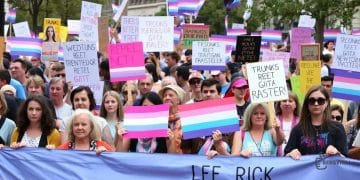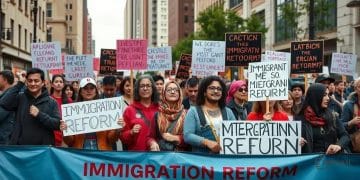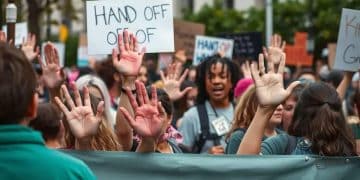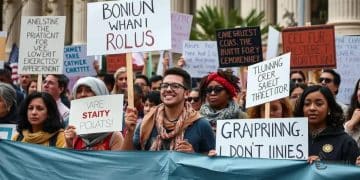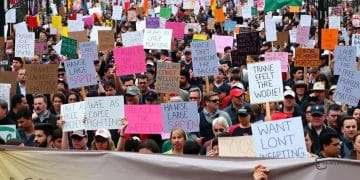LGBTQ+ advocacy marches and demonstrations: a vital push for change
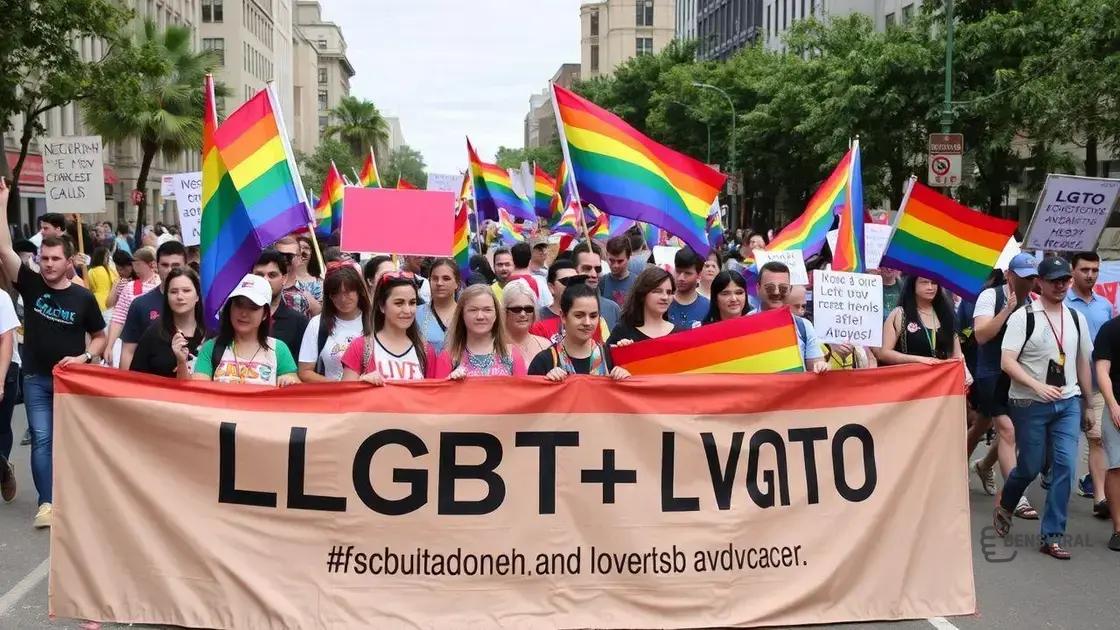
LGBTQ+ advocacy marches and demonstrations are vital for promoting equality, celebrating diversity, and mobilizing support for legal and social changes within the community.
LGBTQ+ advocacy marches and demonstrations are not just events; they are powerful expressions of solidarity and the ongoing fight for rights and recognition. These gatherings bring communities together, inspire change, and remind us of the progress yet to be made. Have you ever considered what these marches mean beyond the celebration?
Understanding the history of LGBTQ+ marches
Understanding the history of LGBTQ+ marches is crucial for recognizing the struggle and progress made over the years. These events have played a significant role in advocating for rights and visibility within society.
From the first major rally in 1970, commemorating the Stonewall Riots, LGBTQ+ marches have evolved into powerful demonstrations. These marches not only represent a fight for equality but also celebrate the diverse identities within the community.
The Early Years of LGBTQ+ Advocacy
In the early years, LGBTQ+ marches were often met with resistance. However, they provided a platform for individuals to express their identities freely. Pioneers of this movement faced considerable challenges, yet they persevered to unite voices.
Key Events in LGBTQ+ March History
- The Stonewall Riots (1969): A turning point for LGBTQ+ activism.
- The first Pride March (1970): Celebrating resilience and unity.
- The AIDS crisis (1980s): Mobilizing the community for healthcare rights.
- Marriage equality demonstrations (2000s): Marking a significant civil rights victory.
As the movement progressed, marches became more organized and inclusive. New groups emerged, aiming to address the concerns of various marginalized communities within the LGBTQ+ spectrum. Today, events are often known as Pride Parades, celebrating love, acceptance, and diversity.
In recent years, these marches continue to serve as a vital tool for advocacy, drawing attention to ongoing issues faced by LGBTQ+ individuals. They remind society of the importance of equality and inclusiveness.
The role of advocacy in societal change
The role of advocacy in societal change is vital, especially in the context of the LGBTQ+ community. Advocacy efforts have historically been essential for raising awareness and pushing for legal reforms.
Through collective voices, movements have emerged that challenge discrimination and promote equal rights. Advocacy not only seeks to change laws but also aims to change hearts and minds.
Key Aspects of Advocacy
Effective advocacy often focuses on education, visibility, and coalition-building. By educating others about the challenges faced by the LGBTQ+ community, advocates can foster understanding and allyship. Visibility during marches and events plays a crucial role in showing the strength and unity of the community.
- Education: Informing the public about LGBTQ+ issues.
- Visibility: Demonstrating strength through public presence.
- Coalition building: Partnering with other marginalized groups.
- Policy change: Lobbying for equal rights and protections.
Advocacy also involves mobilizing individuals to participate in events that highlight these issues. Engaging the community creates a sense of belonging and empowerment. Additionally, advocacy groups often provide resources and support for individuals who feel marginalized.
As the landscape evolves, the role of advocacy continues to expand. New challenges arise, including fighting for trans rights and protections against systemic inequalities. Each generation faces unique battles, yet the foundation of advocacy remains the same: to ensure that every voice is heard and valued.
Key figures and organizations in LGBTQ+ movements
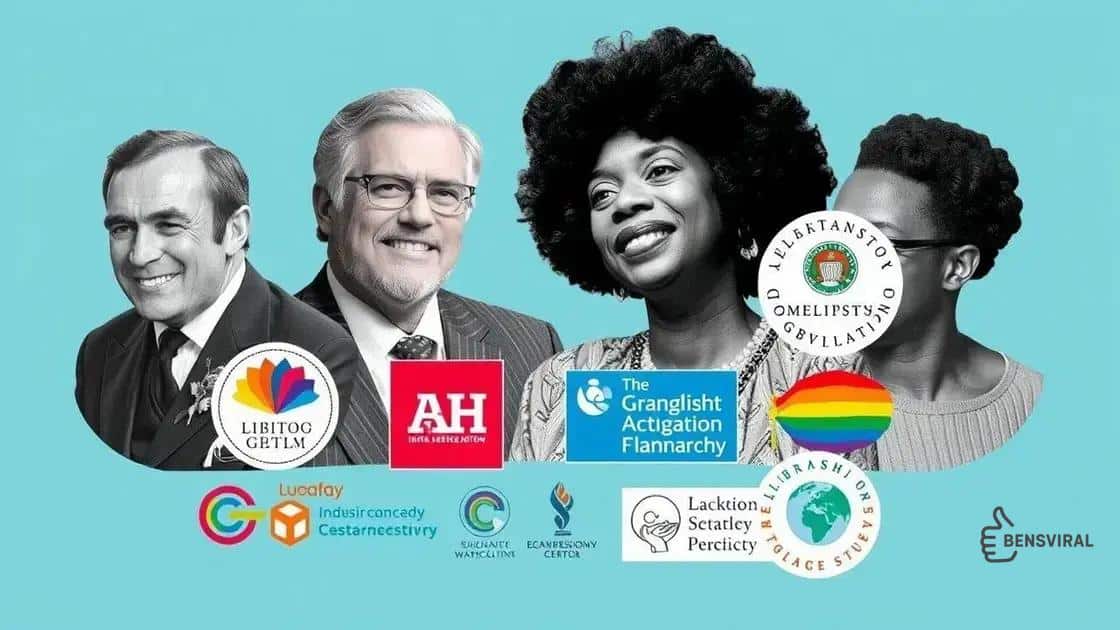
Key figures and organizations in LGBTQ+ movements have significantly shaped the landscape of advocacy. These individuals and groups have fought tirelessly for rights, recognition, and representation in society.
Some prominent figures, like Harvey Milk and Marsha P. Johnson, became iconic for their leadership and dedication. Their efforts brought attention to important issues and mobilized communities across the globe.
Influential Leaders
Many leaders have emerged within the LGBTQ+ community. Each has contributed uniquely to the movement.
- Harvey Milk: The first openly gay elected official in California, he advocated for LGBTQ+ rights in the political arena.
- Marsha P. Johnson: A trans woman and activist, she was a key figure during the Stonewall Riots and co-founded the Street Transvestite Action Revolutionaries (STAR).
- Tyler Clementi: His tragic story raised awareness about bullying and the urgent need for protective policies.
- RuPaul: A cultural icon who popularized drag culture, bringing visibility to the LGBTQ+ community.
Organizations also play a pivotal role in advancing LGBTQ+ rights. They focus on various aspects of advocacy, from education to legal support.
Notable Organizations
Several organizations have emerged as leaders in the fight for equality. These groups advocate for policy changes, provide support, and increase awareness.
- The Human Rights Campaign: This organization works tirelessly to advocate for equal rights and protections for LGBTQ+ individuals.
- GLAAD: Focused on promoting positive representation in media, GLAAD aims to shift cultural attitudes towards LGBTQ+ individuals.
- Lambda Legal: A legal organization that fights for the rights of LGBTQ+ people through litigation and education.
- PFLAG: An organization that supports parents and allies of LGBTQ+ individuals, fostering acceptance and education.
These key figures and organizations have laid the groundwork for advocacy today. They remind us that the fight for equality is ongoing, and the voices of these leaders and groups continue to inspire future generations.
How to participate in upcoming events
Participating in upcoming LGBTQ+ events is a fantastic way to show support and make your voice heard. These gatherings offer an opportunity to connect, celebrate, and advocate for rights and inclusion.
Whether you’re attending a pride march or a community forum, it’s important to prepare. Getting involved can be as simple as showing up and joining the movement.
Finding Events
Start by researching events happening in your area. Many organizations host annual marches, rallies, and community discussions. Here are some tips:
- Check local LGBTQ+ centers for a calendar of events.
- Follow LGBTQ+ organizations on social media for updates.
- Use event platforms like Meetup or Eventbrite to find gatherings.
- Look for community bulletin boards or newsletters.
Getting involved not only means attending, but also actively participating. Understanding the cause and the issues at hand enhances the experience.
Preparing for Events
Once you’ve found an event, consider how to prepare. Wear clothing that shows your support, bring signs if allowed, and stay hydrated. Here are some key steps:
- Plan your transportation and arrive early for the best experience.
- Invite friends or family to join you for a sense of community.
- Bring supplies like water, snacks, and sunscreen for outdoor events.
- Learn about the event’s agenda or speakers to engage more fully.
Engaging with others during events can foster deeper connections. Discussions about personal experiences can lead to greater understanding and support.
Remember, your participation acts as a powerful statement in the fight for equality. Each presence counts and adds to the collective voice calling for change.
Impact of social media on LGBTQ+ activism
The impact of social media on LGBTQ+ activism has been profound. Platforms like Twitter, Instagram, and Facebook have transformed how activists communicate, organize, and raise awareness. These tools provide a voice to those who might not have been heard otherwise.
Social media allows for quick dissemination of information. When events occur, activists can share updates instantly, mobilizing communities quickly. This immediacy has changed the landscape of advocacy and activism.
Building Connections
Through social media, individuals can connect with others who share similar experiences and struggles. These platforms foster community and solidarity, creating safe spaces for discussions about identity and rights.
- Facilitating networking among activists.
- Sharing personal stories to humanize struggles.
- Creating support groups for mental health and well-being.
- Amplifying marginalized voices and perspectives.
Moreover, social media campaigns can raise awareness about critical issues affecting the LGBTQ+ community. Hashtags like #BlackTransLivesMatter and #LoveIsLove serve as rallying cries, drawing attention to ongoing injustices.
Influencing Change
Not only does social media inform, but it also empowers individuals to act. Many campaigns gain traction online, leading to real-world change. Activists can easily mobilize support for petitions, fundraisers, and protests.
- Online petitions gaining signatures quickly.
- Fundraising campaigns for LGBTQ+ organizations receiving wide support.
- Viral videos that raise awareness and prompt discussions.
- Engagement with public officials and businesses for accountability.
As more people join these online conversations, the message of equality and acceptance continues to resonate. Social media serves not just as a platform for activism but as a powerful tool for creating lasting change.
FAQ – Frequently Asked Questions about LGBTQ+ Advocacy
What is the significance of LGBTQ+ advocacy marches?
LGBTQ+ advocacy marches are important for raising awareness, celebrating diversity, and pushing for equal rights and social change.
How can I participate in LGBTQ+ events?
You can participate by attending local marches, joining community organizations, and engaging in online campaigns to show your support.
Why is social media important for LGBTQ+ activism?
Social media amplifies LGBTQ+ voices, facilitates quick information sharing, and creates communities that foster awareness and activism.
Who are some key figures in the LGBTQ+ movement?
Key figures include Harvey Milk, Marsha P. Johnson, and many activists who have shaped the movement through their contributions and leadership.

